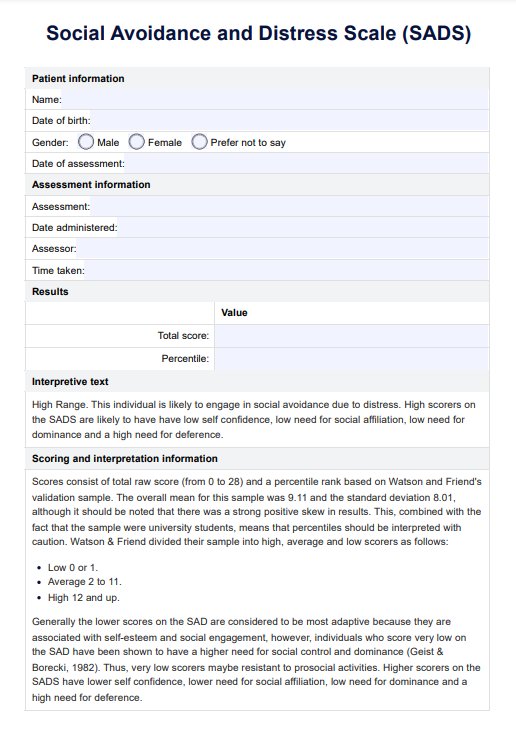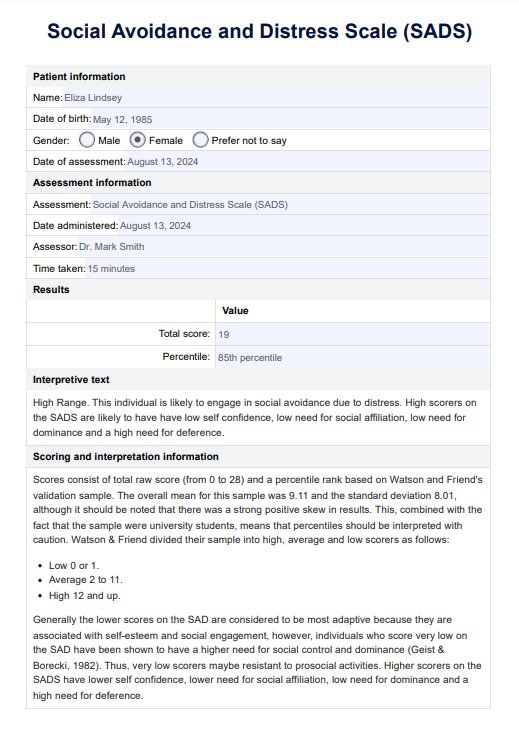Social Avoidance and Distress Scale (SADS)
The Social Avoidance and Distress Scale (SADS) measures social avoidance and distress in individuals. Check out Carepatron's sample download it for free.


What is the Social Avoidance and Distress Scale (SADS)?
The Social Avoidance and Distress Scale (SADS) is a psychological assessment tool commonly used in clinical psychology to measure the level of anxiety and avoidance behaviors in social situations. It is particularly useful in diagnosing affective disorders, such as social anxiety and other anxiety disorders. The scale evaluates the extent of social evaluative anxiety and is applicable to a range of psychiatric disorders, including mood disorders and pervasive developmental disorders.
Developed to aid in the identification of diagnostic criteria for social anxiety, the SADS provides valuable insights into an individual's social functioning. It is often used alongside other assessment tools, such as the State-Trait Anxiety Inventory, to provide a comprehensive understanding of a patient's anxiety levels. The scale is also suitable for use with school-aged children, helping to identify early signs of social anxiety and related issues. By providing a standardized measure, the SADS helps clinicians develop targeted treatment plans and track the progress of interventions aimed at reducing social anxiety and improving overall social functioning.
Social Avoidance and Distress Scale (SADS) Template
Social Avoidance and Distress Scale (SADS) Example
How to use our Social Avoidance and Distress Scale (SADS) template
Through the following these steps, practitioners can ensure that they gain valuable insights into their patients' social interactions and anxiety levels.
Access and download the template
To get started, simply access Carepatron's platform and navigate to the SADS template. You can easily download the template in a convenient format. This template includes both the present and lifetime version of the scale, allowing you to assess your patient's current anxiety levels and any historical patterns of social avoidance. Ensure you have the necessary software to open and edit the file as needed.
Review the template
Before introducing the template to your patients, take time to review it thoroughly. Familiarize yourself with the questions and the scoring system. This knowledge will help you interpret the results accurately. The template has been designed to maintain discriminant and convergent validity, ensuring that it effectively measures social avoidance and distress.
Introduce and educate the template to the patient
When meeting with your patient, introduce the SADS template in a clear and supportive manner. Explain its purpose and how it can benefit them in understanding their social anxiety. Educate them on the scoring system, emphasizing that a strong positive skew may indicate a tendency toward social avoidance, particularly among very low scorers.
Scoring
The Social Avoidance and Distress Scale features a total raw score ranging from 0 to 28, along with a percentile rank based on Watson and Friend’s validation sample from 1969. In this sample, the mean score was 9.11, with a standard deviation of 8.01, though there was a notable positive skew in the data. It is also important to interpret percentiles cautiously since the sample comprised university students.
Scores can be classified into three categories:
- Low social anxiety: 0 or 1
- Average social anxiety: 2 to 11
- High social anxiety: 12 and above
Typically, lower SADS scores are considered more adaptive, correlating with higher self-esteem and greater social engagement. However, individuals with very low scores may display a heightened need for social control and dominance (Geist & Borecki, 1982), which can result in resistance to prosocial behavior.
On the other hand, higher SADS scores tend to indicate lower self-confidence, a reduced desire for social affiliation, diminished need for dominance, and an increased tendency towards deference.
Next steps after using the Social Avoidance and Distress Scale
After completing the assessment with the Social Avoidance and Distress Scale (SADS), medical professionals should take several critical steps to ensure the effective management of their patients' social anxiety and related issues. These steps will help interpret the results and develop appropriate interventions based on the findings.
Analyze scores and percentile ranks
Begin by carefully analyzing the scores obtained from the SADS. Consider how the scores differed from the mean score of the validation sample. Scores that reflect significantly lower values may suggest low self-confidence and a higher risk for developing affective disorders.
Discuss findings with the patient
Share insights about their scores, emphasizing how they relate to social anxiety and potential concerns like substance abuse or other affective disorders. This conversation is essential in fostering an open dialogue, where patients can express their feelings and experiences related to their social interactions.
Develop a treatment plan
Based on the insights gathered from the SADS and the discussion with your patient, collaborate to develop a comprehensive treatment plan. This plan may include therapy options, coping strategies, and support systems to address the identified issues, particularly focusing on enhancing self-confidence and reducing social anxiety.
Monitor progress
As the treatment plan is implemented, regularly monitor the patient’s progress. Use follow-up assessments, including repeat administration of the SADS, to track changes in scores and identify improvements or areas requiring further attention. This ongoing evaluation is particularly important for school-age children, as it helps to ensure they receive the support they need as they navigate social situations and challenges.
References
Geist, & Harris. (1983). Social avoidance and distress: Its relationship to self-confidence, and needs for affiliation, change, dominance, and deference. Journal of Clinical Psychology, 39(5).
Watson, D., & Friend, R. (1969). Measurement of social-evaluative anxiety. Journal of Consulting and Clinical Psychology; Journal of Consulting and Clinical Psychology, 33(4), 448.
Commonly asked questions
The Social Avoidance and Distress Scale (SADS) is a psychological assessment tool designed to measure the level of social anxiety and avoidance behaviors in individuals. It provides insights into how these feelings impact social interactions and overall functioning.
The Social Avoidance and Distress Scale was developed by Watson and Friend as part of their research on social anxiety. Their work laid the foundation for understanding the relationship between social avoidance and distress in various populations.
The four levels of social anxiety disorder are mild, moderate, severe, and extreme. These levels reflect the intensity of symptoms and their impact on an individual's daily functioning, ranging from occasional feelings of anxiety in social situations to debilitating fears that significantly hinder social interactions.
Yes, there are several social anxiety scales, including the Liebowitz Social Anxiety Scale (LSAS) and the Social Phobia Inventory (SPIN). These scales help clinicians assess the severity of social anxiety symptoms and guide treatment planning.





















-template.jpg)


















































































